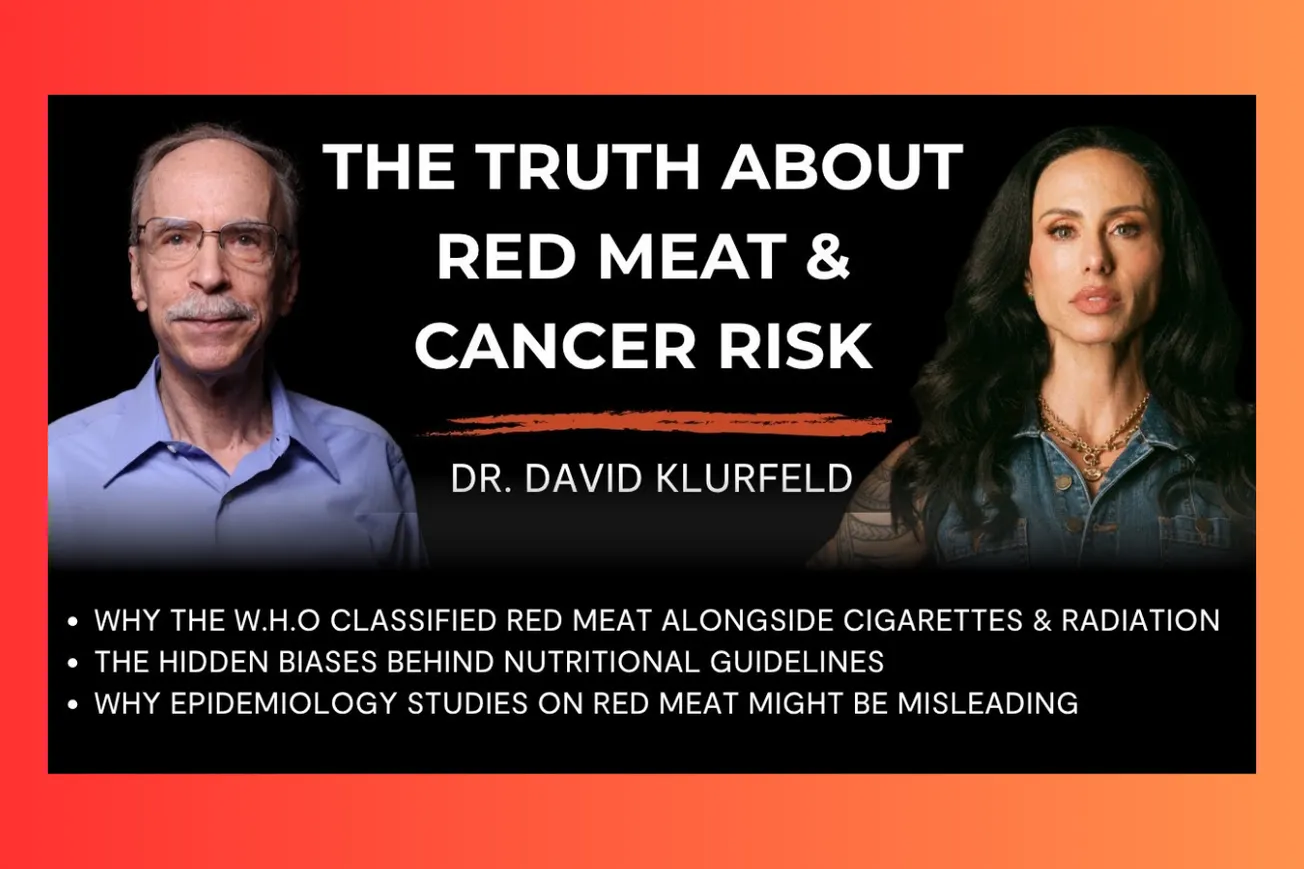Table of Contents
Former USDA scientist Dr. David Klurfeld reveals shocking details about the flawed process that declared red meat carcinogenic, exposing how weak evidence and researcher bias shaped global dietary recommendations.
Inside the room where 22 scientists voted to classify red meat as cancer-causing, despite throwing out 780 of 800 studies and relying on questionable evidence.
Key Takeaways
- The 2015 IARC red meat cancer classification discarded 780 out of 800 studies, basing conclusions on just 18 observational studies
- Half to two-thirds of the IARC committee members were vegetarians, creating potential intellectual conflicts of interest in the decision-making process
- Unprocessed red meat shows no identifiable cancer risk according to Dr. Klurfeld, who served on the controversial working group
- US dietary guidelines have remained virtually unchanged since 1980 despite lack of scientific evidence supporting low-fat recommendations
- The Women's Health Initiative, a $750 million study, found no benefit from low-fat diets on colon cancer, breast cancer, or heart disease
- Nutritional epidemiology relies on flawed food questionnaires and statistical associations that cannot prove causation between diet and disease outcomes
- Animal studies used to justify red meat warnings fed calcium-deficient rats blood sausage, not actual meat consumed by humans
Timeline Overview
- 00:00:00–00:13:17 — "Consumption of raw red meat, unprocessed red meat, I don't think has any identifiable cancer risk at all" - Introduction to the global red meat cancer claim that "went global" with little understanding of its origins. Dr. Klurfeld's credentials as former USDA scientist who helped write dietary guidelines.
- 00:13:17–00:31:04 — IARC methodology exposed - "Low quality like lowquality evidence" with four subcommittees where animal experiments "did not contribute to making a decision about red meat because some saw an increase, some saw no change and some saw a decrease." Mechanistic studies were "highly problematic" as none were shown to occur in people eating meat.
- 00:31:04–00:48:14 — Statistical cherry-picking revealed - Commentary on frequently quoted studies claiming 10-19% lower mortality from replacing red meat with plant protein, and the 17% colorectal cancer risk increase "that comes from the ARC review." Discussion of how modern science has "a lot less randomized control trials, uh a lot less rigor."
- 00:48:14–01:06:18 — USDA research infrastructure and harassment - Overview of six human nutrition research centers with metabolic wards capable of controlled feeding studies. Harassment by activist groups requesting "seven years of emails" related to public-private partnerships for nutrition research funding.
- 01:06:18–01:28:36 — Dietary guidelines evolution disaster - From 1992 food guide pyramid with "grains should form the base 6 to 11 servings and fats were placed as the top to be used sparingly" through MyPlate. The missing conversation about dietary protein despite decades of research advancement.
- 01:28:36–01:49:45 — Bioactive compounds and supplement philosophy - Discussion of creatine, carnosine, anserine and other nutrients in meat. "I would prefer people to get their nutrition first from foods and only secondarily from supplements. Now, if you're going to be a vegan, supplements are now a new food group for you."
The Making of a Global Health Scare
The message that red meat causes cancer spread worldwide, but few understood its origins. Dr. David Klurfeld, who spent 16 years at the USDA overseeing 600 scientists and an $80 million budget, was inside the room when 22 experts made this controversial decision. His revelation: "This was the most frustrating professional experience of my life."
- The International Agency for Research on Cancer (IARC) classified red meat as "probably carcinogenic" based on limited evidence from humans
- Processed meat received the more severe "carcinogenic to humans" classification, placing it alongside smoking and radiation in Group 1
- The working group relied primarily on observational studies rather than controlled experiments, despite known limitations of this methodology
- No systematic review or meta-analysis was conducted, violating standard medical research practices even a decade ago
The classification process revealed fundamental problems with how scientific evidence gets translated into public health recommendations. Committee members had to apply to participate, creating a self-selected group with potential biases toward finding harmful effects.
Inside the IARC Decision-Making Process
Dr. Klurfeld's firsthand account exposes serious methodological flaws in the process that shaped global dietary recommendations. The working group's composition and procedures raised immediate red flags about scientific objectivity.
- Eleven of 22 scientists were epidemiologists, automatically outnumbering other scientific disciplines in the decision-making process
- Many committee members were friends who had served on previous IARC panels and already published studies linking meat to cancer risk
- The first dinner revealed widespread vegetarianism among participants, including the head of nutrition for the World Health Organization
- Animal studies showed mixed results - some increased cancer risk, others showed no change, and some actually decreased risk
The committee relied heavily on mechanistic studies that only demonstrated what was theoretically possible, not what actually occurred in people eating meat. These mechanisms were only shown in calcium-deficient rats fed blood sausage, not healthy animals consuming actual meat products.
Dr. Klurfeld's animal research subcommittee concluded that experimental evidence "did not contribute to making a decision about red meat" due to inconsistent and contradictory findings across studies.
The Statistical Sleight of Hand
The IARC monograph claimed to review over 800 studies but used only 18 in their final analysis. This massive exclusion rate raises serious questions about cherry-picking data to support predetermined conclusions.
- 780 studies were discarded because they "didn't show anything or didn't show the right result"
- The committee focused exclusively on epidemiological associations while dismissing controlled experimental evidence
- Statistical significance hunting created thousands of potential false positives from multiple comparisons in dietary studies
- With over 100,000 potential food-disease combinations analyzed, researchers expect 6,000 false positives based on standard statistical thresholds
Dr. Klurfeld illustrates the absurdity of confusing correlation with causation through examples like cheese consumption correlating with divorce rates in Maine. These spurious associations highlight how epidemiological studies can create misleading connections between unrelated variables.
The NIH-AARP study of over 500,000 people perfectly demonstrated this problem. Red meat consumption correlated with increased deaths from cancer, heart disease, and accidents. "Tell me how eating a roast beef sandwich makes you get into a fatal accident," Dr. Klurfeld challenges, exposing the fundamental flaw in assuming causation from correlation.
Dietary Guidelines: 40 Years of Unchanged Recommendations
Despite decades of research and hundreds of millions in funding, US dietary guidelines have remained virtually identical since 1980. This consistency suggests either remarkable scientific stability or institutional inertia resistant to new evidence.
- The 1980 guidelines consisted of a 9-page pamphlet based on expert opinion rather than systematic evidence review
- By 2020, guidelines expanded to 150 pages with extensive scientific documentation but identical core recommendations
- Low-fat recommendations originated from arbitrary targets set by the American Heart Association, not biological research
- The 30% fat target represented a compromise between the desired 20% goal and recognition that "nobody will reach 20%"
The saturated fat recommendation of 10% or less came from thin air according to Dr. Klurfeld. The American Heart Association divided fats into thirds - saturated, monounsaturated, and polyunsaturated - without scientific justification for these specific proportions.
School lunch programs still mandate skim or low-fat milk for children, demonstrating how decades-old recommendations persist despite evolving scientific understanding about dietary fats and child nutrition.
The Women's Health Initiative: A $750 Million Reality Check
The largest nutrition intervention study in history provided definitive evidence that low-fat diets don't prevent chronic diseases, yet this finding barely influenced dietary recommendations or public health messaging.
- 50,000 women followed either low-fat diets or their usual eating patterns for nine years
- No differences emerged in colon cancer, breast cancer, or heart disease rates between groups
- The intervention successfully reduced fat intake but produced no measurable health benefits
- Results contradicted decades of epidemiological studies suggesting low-fat diets prevent chronic diseases
Dr. Klurfeld brought this study to the IARC committee as evidence that meat reduction doesn't prevent cancer. An epidemiologist dismissed it because "that study wasn't designed primarily to look at red meat," despite meat intake being cut in half.
This response exemplified the double standard applied to different types of evidence. None of the observational studies supporting meat-cancer links were specifically designed to study red meat either, yet these formed the foundation for the cancer classification.
The Beef Matrix: Why Whole Foods Aren't Single Nutrients
Dr. Klurfeld's concept of the "beef matrix" challenges reductionist approaches that treat foods as collections of isolated nutrients rather than complex biological structures with interactive components.
- Beef contains muscle tissue, connective tissue, fat, and cell membranes in specific physical arrangements
- Dairy research demonstrates that milk fat globule membranes produce different metabolic effects than extracted butter fat
- Heme iron content varies significantly between beef, pork, and poultry, affecting bioavailability and nutritional value
- Bioactive compounds like creatine, carnosine, and anserine provide benefits beyond basic protein and micronutrient content
The matrix concept explains why extracting beef tallow produces different physiological effects than consuming intact meat. This physical structure influences digestion, absorption, and metabolism in ways that nutrient databases cannot capture.
Selenium exemplifies this complexity. Beef provides roughly half of Americans' selenium intake, but imported Italian pasta contains virtually zero selenium due to soil differences. These geographical and processing variations make standardized nutrition recommendations problematic.
The Microbiome Revolution and Research Limitations
Modern nutrition research faces unprecedented complexity as scientists discover the intestinal microbiome's massive influence on health outcomes. This bacterial ecosystem wasn't even taught in medical schools when Dr. Klurfeld began his career.
- The same number of bacterial cells live in human intestines as in the entire human body
- These bacteria produce chemicals that get absorbed and participate in normal metabolism
- Current research only analyzes expelled bacteria in feces, missing activity throughout 26 feet of intestinal tract
- Approximately 1,200 bacterial species can inhabit humans, but individuals may host completely different combinations
The microbiome's complexity makes personalized nutrition increasingly important while simultaneously making population-wide dietary recommendations less meaningful. Individual bacterial populations could explain why identical foods produce different health outcomes in different people.
Dr. Klurfeld participated in the human gut microbiome project but admits: "They told me who lives there, and I have no idea what that means." This honest assessment reflects the field's current limitations despite rapid technological advances.
The Crisis of Nutritional Epidemiology
Observational nutrition studies face insurmountable methodological problems that prevent reliable causal conclusions, yet these studies continue forming the basis for dietary recommendations and media headlines.
- Food frequency questionnaires miss 75% of actual dietary intake according to USDA research requiring 3-35 recalls for accuracy
- Most studies use only one or two dietary assessments to represent decades of eating patterns
- Healthy user bias confounds results when health-conscious people adopt multiple beneficial behaviors simultaneously
- Statistical adjustments for confounding variables remain inadequate for the complexity of lifestyle interactions
The NIH-AARP study perfectly illustrated these problems. People eating more red meat had higher death rates from every cause including accidents, while those eating more poultry had lower death rates from everything except heart disease. These patterns reveal unmeasured lifestyle differences rather than food-specific effects.
Dr. Klurfeld's career transformation from accepting observational studies to recognizing their limitations represents a broader awakening in nutrition science about methodological weaknesses that undermine public confidence and policy effectiveness.
Common Questions
Q: What is the actual evidence that red meat causes cancer?
A: Very weak - based on 18 observational studies out of 800 reviewed, with no controlled trials supporting causation.
Q: Why do dietary guidelines remain unchanged despite new research?
A: Institutional inertia and reluctance to admit decades of recommendations lacked solid scientific foundation from the beginning.
Q: How reliable are nutrition studies reported in the media?
A: Single studies, especially observational ones, cannot prove causation and should never dictate dietary changes or health recommendations.
Q: What makes beef different from other protein sources?
A: The beef matrix includes unique combinations of heme iron, bioactive compounds, and physical structures that influence digestion and metabolism.
Q: Why are randomized controlled trials rare in nutrition research?
A: They're expensive, time-consuming, ethically challenging, and vulnerable to participant non-compliance over extended periods.
The red meat cancer scare demonstrates how scientific institutions can amplify weak evidence into global health recommendations. Dr. Klurfeld's insider perspective reveals the urgent need for higher evidence standards and intellectual honesty in nutrition research.





